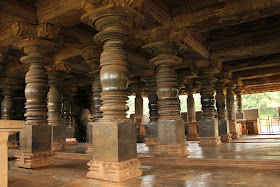Sri Madhu Kaitabha Temple of Kotipura is one of the most beautiful temples of Shimoga district. The temple is also known as Kaitabesvaragudi. It is the largest of seven temples here. A board gave out useful information about these temples.
Kubatur was ruled by the Kadambas (3-6th centuries AD), Chalukyas of Badami (6th century) Rastrakutas (7-8th centuries), Chalukya's of Kalyan (11-12th centuries), Hoysalas of Dorasamudra (11-13th centuries), Nayakas of Keladi (15-16th centuries) and was part of Banavasi-12000 province under the governance of Hoysala Vinayaditya.
The Kaitabhesvara Temple of Kubatur is one of the early temples of the Hoysala period of Vinayaditya datable to AD 1100 and is known as Kotishvara in inscriptions. Stylistically, it closely resembles the Chalukyan temples in plan, pillar order and Sikhara. The temple is east-west orientation, on plan has a Garbhagriha, a vestibule and an indented square Sikhara and Sukasana. The sculptures of Mahishamardini, Bhairava and Ganesa adorn the superstructure. There are five entrances to the Mukhamantapa. Lateral entrances are provided in addition to the conventional northern, southern and eastern entrances. The pillars of the Mandapa are circular, lathe turned and polished abd those places over the Jagati are fluted and shorter. The ceilings are ornate and the parapet placed over the heavy typical Hoysal eave has the structural representations of Ugra Narasimha, Varaha, Garuda, Kesava, etc. The Sukanasi and Garbhagriha doorways are of typical Hoysala ornate variety with Gajalakshmi at the lintel. A rare inscription in this temple refers to major temple forms of India mastered by a talented architect.
As you see the temple complex is well maintained. I was here by 8AM and happened to meet a group of boys who had come to see the temple. Since there was no guide I asked these boys to show me around.

The temple is similar to Nagaresvaragudi of Bankapur and Tarakesvaragudi of Hangal.

The Shikhara. This temple is Ekakuta meaning a temple with one Garbhagudi. One of the boys pointed out an iron ring at the top, it is visible if you enlarge the image. Another one of the iron object can be seen on the opposite side. The boys mentioned did mention how those objects happen to be there ...should have written it down.

Another view of the Shikhara.

The interior has a matrix of beautifully sculpted and polished pillars. This space is usually called as Navaranga Mantapa or Sabha Mantapa, a place for people to gather and discuss social matters.

Another view of the Navaranga Mantapa. The temple features Sukanasi around this hall. Sukanasi is a raised platform for people to be sit on.

How well the pillar is made! I'm trying to imagine to what extent engineers and builders of those days were dedicated to their profession. Did they possess some kind of Divine power?

An intricately sculpted part of the ceiling.

Halegannada inscriptions on the Sukanasi. This is not the only one, the temple had inscriptions on seven or eight places, few on Sukanasi and few on flat portions of the pillars. One of boys spotted a peacock drawing inscribed on one of the pillars. Kids are good company :) their enthusiasm is contagious.

A close look at a few words. No scope for making typos. No chance for typos- back then there was no backspace.

Ancient version of board games. You can see two of them here. The one in the background is Chakka-Bara, a game played to this day.

A little Basavanna at the temple entrance.

The temple complex has a small collection of hero-stones and few sculptures. A royal couple standing below Sun, Moon, Vishnu Shankha and Chakra.

Another hero-stone depicting a battle scene. The damaged top features crescent moon, a man performing pooja to Shivalinga and a Basavanna.

A little temple in a pit without a deity.

The front portion is decorated with finely sculpted art. This little temple reminds me of Billeswara temple of Hangal.

Men riding imaginative creatures; body of a horse and heads of various animals and birds.

A little temple dedicated to Shivalinga.


Temple dedicated to snake gods.

My friends- Naveen, Maltesh, Vinayaka and Mahesh. If I'm not mistaken this temple is dedicated to goddess Chenglavva.

Two more temples of which one is used like a store room.

I learn that my four friends were from Anavatti, about a kilometer from this temple. I asked them if they have seen Anavatti fort. The answer was yes but nothing is left of it. A two minute drive, we were at the spot.

Houses and shops can be seen where Anavatti fort walls stood.

Couple of teenage boys living in one of the houses gave strange looks and one of them even called another boy- "aaoji yeha." ...as if their houses were about to be demolished. This is what remains of Anavatti fort, just like many other forts of Karnataka.

My friends said bye. I promised to send their pictures. Our next destination was Belligavi about 25km from here. We decided to have breakfast and proceed.
Kotipura temple complex Coordinates: 14°34'32"N 75°8'50"E
.........